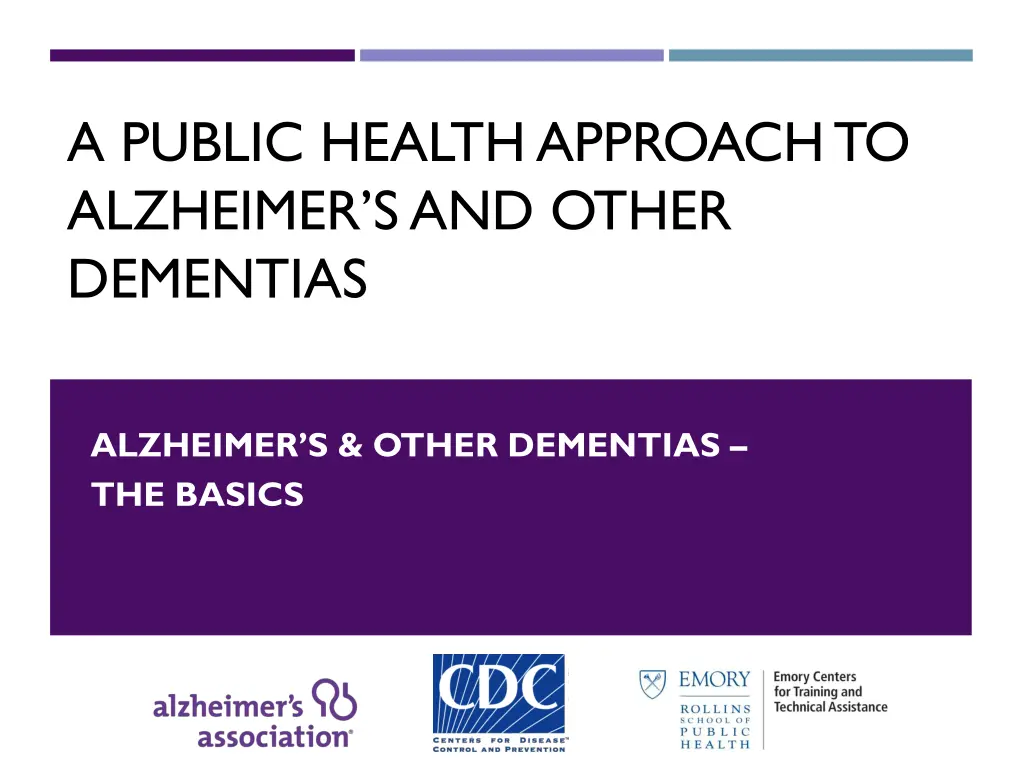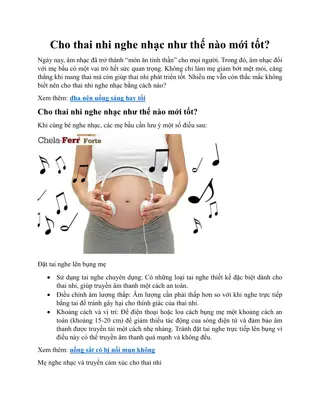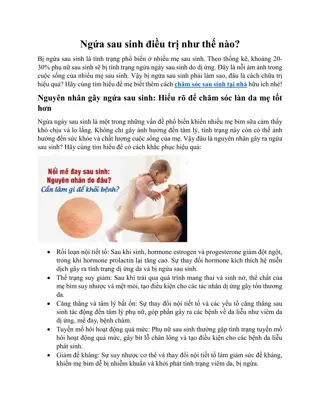
Understanding Cognitive Health: Alzheimer's & Dementia Basics
Explore the fundamentals of cognitive health, dementia, and Alzheimer's disease. Learn about symptoms, risk factors, caregiver roles, and competencies in public health approaches. Understand cognitive aging and brain changes with age.
Download Presentation

Please find below an Image/Link to download the presentation.
The content on the website is provided AS IS for your information and personal use only. It may not be sold, licensed, or shared on other websites without obtaining consent from the author. If you encounter any issues during the download, it is possible that the publisher has removed the file from their server.
You are allowed to download the files provided on this website for personal or commercial use, subject to the condition that they are used lawfully. All files are the property of their respective owners.
The content on the website is provided AS IS for your information and personal use only. It may not be sold, licensed, or shared on other websites without obtaining consent from the author.
E N D
Presentation Transcript
A PUBLIC HEALTH APPROACH TO ALZHEIMER S AND OTHER DEMENTIAS ALZHEIMER S & OTHER DEMENTIAS THE BASICS
LEARNING OBJECTIVES Define cognitive health Define and differentiate between dementia and Alzheimer s List at least 5 common symptoms of Alzheimer s Describe the changes that occur during the course of Alzheimer s Identify at least 3 risk factors associated with Alzheimer s Describe the role of caregivers 2
COMPETENCIES Association for Gerontology in Higher Education (AGHE): 1.2.1 Distinguish normal biological aging changes from pathology including genetic factors. 1.3.3 Demonstrate knowledge of signs, symptoms, and impact of common cognitive and mental health problems in late life (e.g., dementia, depression, grief, anxiety). 1.2.4 Recognize common late-life syndromes and diseases and their related bio- psycho-social risk and protective factors. Association of Schools and Programs of Public Health (ASPPH): Domain 1: Describe risk factors and modes of transmission for infectious and chronic diseases and how these diseases affect both personal and population health. 3
COMPETENCIES CONT. National Association of Chronic Disease Directors (NACDD): Domain 7: Discuss the underlying causes and management of chronic diseases, including behavioral, medical, genetic, environmental and social factors. Domain 7: Articulate key chronic disease issues. Domain 7: Describe socioeconomic and behavioral determinants of health disparities. National Commission for Health Education Credentialing, Inc. (NCHEC): 7.1.1 Identify current and emerging issues that may influence health and health education 4
DISCUSSION QUESTION What is cognitive health? 5
COGNITIVE HEALTH Cognition: the ability to think, learn, and remember Cognitive health continuum: optimal functioning to severe disability Linked to brain health 1 Centers for Disease Control and Prevention, Division of Healthy Aging. What is a Healthy Brain? New Research Explores Perceptions of Cognitive Health Among Diverse Older Adults. 6
COGNITIVE AGING The brain changes as it ages Increase in wisdom and expertise Speed of processing, making decisions, remembering may decline Normal part of aging 7 2 Institute of Medicine. (2015) Cognitive Aging: Progress in Understanding and Opportunities for Action. 3 National Institute on Aging. (2013) Understanding Memory Loss: What To Do When you Have Trouble Remembering.
MILD COGNITIVE IMPAIRMENT (MCI) Difficulty with cognitive processes Not severe enough to interfere with daily life Increased risk of Alzheimer s or dementia May be caused by external factors (vitamin B12 deficiency, depression) 4 Alzheimer s Association. (2012) Mild Cognitive Impairment. 5 National Institute on Aging, About Alzheimer s Disease: Mild Cognitive Impairment. Accessed June 10, 2015 from website: https://www.nia.nih.gov/alzheimers/topics/mild-cognitive-impairment. 8
COGNITIVE IMPAIRMENT Difficulty with cognitive processes that affect everyday life Spans wide range of functioning Can occur as a result of Alzheimer s, dementia, stroke, traumatic brain injury 6 Alzheimer s Association and Centers for Disease Control and Prevention. (2013) The CDC Healthy Brain Initiative: Public Health Road Map for State and National Partnerships, 2013-2018. 9
DEMENTIA ALZHEIMER S AND OTHER DEMENTIAS THE BASICS 10
DEMENTIA Decline in mental ability severe enough to interfere with daily life Not a specific disease Not normal aging Caused by damage to brain cells from disease or trauma Many dementias are progressive 11 7 Alzheimer s Association. What is Dementia? Accessed June 8, 2015 from website: http://www.alz.org/what-is-dementia.asp#causes
TYPES OF DEMENTIA Alzheimer s disease Vascular dementia Dementia with Lewy Bodies (DLB) Mixed dementia Parkinson s disease Frontotemporal dementia Creutzfeldt-Jakob disease Normal pressure hydrocephalus Huntington s disease Wernicke-Korsakoff Syndrome 12 8 Alzheimer s Association. Types of Dementia. Accessed June 8, 2015 from website: http://www.alz.org/dementia/types-of-dementia.asp. National Institute on Aging. (2015) Alzheimer s Disease Fact Sheet.
VASCULAR DEMENTIA 2nd most common cause of dementia 20% - 30% of cases Caused by conditions that block or reduce blood flow to the brain Symptoms may occur suddenly following strokes or slowly as a result of cumulative damage 9 Alzheimer s Association. (2015) Vascular Dementia. 13
ALZHEIMERS DISEASE ALZHEIMER S AND OTHER DEMENTIAS THE BASICS 14
ALZHEIMERS DISEASE: OVERVIEW Most common type of dementia 60% - 80% of cases Progressive symptoms gradually worsen over number of years 10 Alzheimer s Association. What is Alzheimer s? Accessed June 8, 2015 from website: http://www.alz.org/alzheimers_disease_what_is_alzheimers.asp 15
ALZHEIMERS DISEASE: HISTORY Identified in 1906 by Dr. Alois Alzheimer Examined brain of woman who died after mental illness Found abnormal clumps (plaques) and tangled fibers (tangles) 16 11 National Institute on Aging. (2015) Alzheimer s Disease Fact Sheet.
ALZHEIMERS DISEASE: PHYSICAL CHANGES Brain shrinks dramatically o Nerve cell death o Tissue loss Plaques: abnormal clusters of protein fragments Tangles: twisted strands of another protein 17 12 Alzheimer s Association. Brain Tour. Accessed July 1, 2015 from website: http://www.alz.org/braintour/3_main_parts.asp
ALZHEIMERS DISEASE: CAUSES Precise changes in brain largely unknown Probably develops as a result of complex interactions among: o Age o Genetics o Environment o Lifestyle o Coexisting medical conditions 18 13 Alzheimer s Association. Risk Factors. Accessed June 8, 2015 from website: http://www.alz.org/alzheimers_disease_causes_risk_factors.asp
YOUNGER-ONSET ALZHEIMERS DISEASE Affects people younger than 65 Many are in their 40s and 50s 200,000 have younger onset (in U.S.) 4% of population with Alzheimer s 14 Alzheimer s Association. Younger/Early Onset Alzheimer s & Dementia. Accessed June 8, 2015 from website: http://www.alz.org/alzheimers_disease_early_onset.asp 19
DISCUSSION QUESTION What are the characteristics of Alzheimer s disease? 20
10 WARNING SIGNS OF ALZHEIMERS Memory loss that disrupts daily life 1. Challenges in planning or solving problems 2. Difficulty completing familiar tasks 3. Confusion with time or place 4. Trouble understanding visual images and spatial relationships 5. 21 15 Alzheimer s Association. (2009) Know the 10 Signs.
10 WARNING SIGNS OF ALZHEIMERS (CONTINUED) New problems with words in speaking or writing 6. Misplacing things and losing the ability to retrace steps 7. Decreased or poor judgment 8. Withdrawal from work or social activities 9. 10. Changes in mood and personality 16Alzheimer s Association. (2009) Know the 10 Signs. 22
STAGES OF ALZHEIMERS DISEASE Average lifespan 4-8 years after diagnosis; as long as 20 years Progresses slowly in 3 stages: o Mild (early-stage) o Moderate (middle-stage) o Severe (late-stage) 17 Alzheimer s Association. Stages of Alzheimer s. Accessed June 8, 2015 from website: http://www.alz.org/alzheimers_disease_stages_of_alzheimers.asp 23
MILD ALZHEIMERS (EARLY-STAGE) Able to function independently Common difficulties: o Forgetting familiar words o Losing everyday objects o Trouble remembering names o Greater difficulty performing tasks o Forgetting material just read o Increasing trouble with planning, organizing 24 18Alzheimer s Association. Stages of Alzheimer s. Accessed June 8, 2015 from website: http://www.alz.org/alzheimers_disease_stages_of_alzheimers.asp
MODERATE ALZHEIMERS (MIDDLE-STAGE) Requires increasing care Symptoms include: o Forgetfulness of personal history o Confusion about place or time o Need for help with bathing, toileting, dressing o Changes in sleep patterns o Increased risk of wandering o Personality and behavioral changes 25 19Alzheimer s Association. Stages of Alzheimer s. Accessed June 8, 2015 from website: http://www.alz.org/alzheimers_disease_stages_of_alzheimers.asp
SEVERE ALZHEIMERS (LATE-STAGE) Typically longest stage Requires full-time care Loss of awareness of recent experiences and surroundings Changes in physical abilities (walking, sitting, swallowing) Vulnerable to infections 20Alzheimer s Association. Stages of Alzheimer s. Accessed June 8, 2015 from website: http://www.alz.org/alzheimers_disease_stages_of_alzheimers.asp 26
RISK FACTORS ALZHEIMER S AND OTHER DEMENTIAS THE BASICS 27
RISK FACTORS: AGE #1 risk factor is advancing age Approximately doubles every 5 years after age 65 1 in 3 people age 85 21Alzheimer s Association. Risk Factors. Accessed June 8, 2015 from website: http://www.alz.org/alzheimers_disease_causes_risk_factors.asp 22Alzheimer s Association, 2015 Alzheimer s Disease Facts and Figures, March 2015 28
RISK FACTORS: FAMILY HISTORY, EDUCATION Family history Hereditary/Genetics Education, cognitive engagement 23Alzheimer s Association. Risk Factors. Accessed from website: http://www.alz.org/alzheimers_disease_causes_risk_factors.asp 29
RISK FACTORS: RACE & ETHNICITY African-Americans: 2 times greater risk Hispanics: 1.5 times greater risk Cardiovascular risk factors more common Lower levels of education, socioeconomic status 30 24Alzheimer s Association (2016) Alzheimer s Disease Facts and Figures
RISK FACTORS: WOMEN 2/3 of affected population 16% of women age 71 (11% of men) At age 65 have more than 1 in 6 chance (1 in 11 for men) Age 60, are twice as likely to develop Alzheimer s than breast cancer 25Alzheimer s Association, AAIC Press Release, July 21, 2015 26Alzheimer s Association, Public Health E-News, July 22, 2015 31
MODIFIABLE RISK FACTORS: HEAD TRAUMA Moderate and severe traumatic brain injury o Moderate injury: 2.3 times greater risk o Severe injury: 4.5 times greater risk Risk remains for years after injury 27Alzheimer s Association. (2015) Traumatic Brain Injury. 32
MODIFIABLE RISK FACTORS: LIFESTYLE Increases risk Current smoking Midlife obesity Decreases risk Physical activity Heart-healthy diets: DASH, Mediterranean diet Mental and social activity 33 28Alzheimer s Association. (2014) Alzheimer s and Public Health Spotlight: Heart Health and Brain Health. 29Alzheimer s Association. Prevention and Risk of Alzheimer s & Dementia. Accessed July 16, 2015 from website: http://www.alz.org/research/science/alzheimers_prevention_and_risk.asp
MODIFIABLE RISK FACTORS: CARDIOVASCULAR Heart-head connection Cardiovascular risk factors: o High blood pressure in midlife o Heart disease o Stroke o Diabetes 34 30Alzheimer s Association. Prevention and Risk of Alzheimer s & Dementia. Accessed July 16, 2015 from website: http://www.alz.org/research/science/alzheimers_prevention_and_risk.asp
TREATMENT & MANAGEMENT ALZHEIMER S AND OTHER DEMENTIAS THE BASICS 35
DIAGNOSING ALZHEIMERS DISEASE No single test Medical evaluation o Medical history o Mental status testing o Information from family and friends o Physical and neurological exams o Rule out other causes 36 31Alzheimer s Association. Diagnosis of Alzheimer s Disease and Dementia. Accessed June 8, 2015 from website: http://www.alz.org/alzheimers_disease_diagnosis.asp
TREATING & MANAGING ALZHEIMERS No cure Drug and non-drug treatments Primary goals of treatment: o Maintain quality of life o Maximize function in daily activities o Enhance cognition, mood, behavior o Foster safe environment o Promote social engagement 37 32 Alzheimer s Association. Health Care Professionals and Alzheimer s. Accessed June 8, 2015 from website: http://www.alz.org/health-care-professionals/medical-management-patient-care.asp
ALZHEIMERS: CO-MORBIDITIES Additional chronic conditions (e.g., heart disease, diabetes, depression) Difficult to manage Higher rates of hospitalizations and costs o 3 times as many hospital stays o 3 times average Medicare costs Preventable hospitalizations 38 33Alzheimer s Association. (2013) Combating Alzheimer s Disease: A Public Health Agenda.
UNIQUE ASPECTS ALZHEIMER S AND OTHER DEMENTIAS THE BASICS 39
ALZHEIMERS: UNIQUE ASPECTS Financial hardship o May lose income and savings o Increased reliance on public programs Stigma Vulnerability to abuse 40 34Alzheimer s Association. Abuse. Accessed July 16, 2015 from website: https://www.alz.org/care/alzheimers-dementia-elder-abuse.asp
CAREGIVERS ALZHEIMER S AND OTHER DEMENTIAS THE BASICS 41
ALZHEIMERS: CAREGIVERS Responsibilities: o Dressing, bathing, toileting, feeding o Shopping, meal preparation, transportation o Medication o Financial management o Emotional support Increasing levels of care Results in complete dependence 35 Alzheimer s Association. (2015) Alzheimer s Disease Caregivers. 42
CAREGIVERS: CHALLENGES Physical, financial, psychological challenges o $10.2 billion additional annual health care costs (2015) o 60% rate emotional stress as high or very high o 40% suffer from depression 43 36 Alzheimer s Association. 2016 Alzheimer s Disease Facts and Figures.
CONCLUSION: KEY POINTS Disease likely develops as result of multiple factors Symptoms worsen over time; average lifespan 4-8 years (up to 20) Risk factors include: age, family history, head trauma, education, lifestyle, cardiovascular conditions African-Americans, Hispanics, women more likely to develop 44
ROLE OF PUBLIC HEALTH 3 key public health intervention tools: o Surveillance/monitoring o Primary prevention (risk reduction) o Early detection and diagnosis 45
DEMENTIA CAPABLE SYSTEMS AND DEMENTIA FRIENDLY COMMUNITIES Dementia capable systems o Public health research and translation o Support services o Workforce training Dementia friendly communities 46
FOR MORE INFORMATION For more information, please visit the Alzheimer s Association website at: http://www.alz.org 47






















